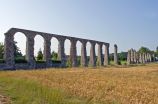Is that Ginkgo biloba supplement really what you think it is?
DNA barcoding used to check authenticity of popular herbal supplements
2014-12-11
(Press-News.org) Dr. Damon Little, Associate Curator of Bioinformatics in the Cullman Program for Molecular Systematics at The New York Botanical Garden, has just published a new study in the journal Genome investigating the use of DNA barcoding to test the authenticity of Ginkgo biloba (G. biloba), an herbal dietary supplement sold to consumers that is supposed to boost cognitive capacity. Unfortunately, herbal supplements on the market are subject to mislabelling, and therefore consumers may not be getting the products and benefits they believe they are getting.
Dr. Little's research is part of a larger effort to evaluate many of the popular herbal supplements on the retail market. He explains two potential dangers of mislabelled supplements: (1) some adulterants are toxic (alone or in combination with other supplements/drugs); and (2) consumers may not receive the health benefit they seek from mislabelled supplements, potentially worsening their health.
It seems herbal products can be mislabelled either because the supplier incorrectly identified the plant materials (some grow their own materials; some contract with growers; some buy raw materials in bulk; and some buy processed materials in bulk) or because another (usually less expensive) material was substituted.
Although it is difficult to determine how or why a supplement is mislabelled, the process developed with this new research can help to estimate the frequency of mislabelled supplements on the market. It also provides a validated method that can be used by supplement manufacturers for better quality control.
Dr. Little has designed a novel DNA mini-barcode assay that can validate authenticity of G. biloba in herbal dietary supplements.
"I found that 83.8% of ginkgo supplements certainly contained ginkgo. In comparison, previous work has shown that 75% of black cohosh (Actaea racemosa) and 85% of saw palmetto (Serenoa repens) supplements contained the correct species," says Dr. Little. "For the supplements in which I found no evidence of ginkgo, I cannot be sure if that is because the DNA was destroyed (for example by drying at very high temperatures) or if the samples simply do not contain any ginkgo."
In any case, it is hoped that this assay will be used by supplement manufacturers to ensure their supplements contain the expected ingredients.
Dr. Little intends to continue this line of research with a focus on other popular herbal supplements.
INFORMATION:
"Authentication of Ginkgo biloba herbal dietary supplements using DNA barcoding" was published online today in the journal Genome. < http://www.nrcresearchpress.com/doi/abs/10.1139/gen-2014-0130>
ELSE PRESS RELEASES FROM THIS DATE:
2014-12-11
Tampa, FL (Dec. 11, 2014) -- Despite emerging evidence otherwise, many college students consider hookah smoking safer than smoking cigarettes, reports a University of South Florida (USF) College of Public Health study published this month by the Centers for Disease Control and Prevention (CDC).
The study, appearing online in the CDC journal Preventing Chronic Disease, examined the prevalence of hookah use and described social and behavioral factors associated with hookah smoking among students at USF, a large urban public university in Tampa, Fla. The research suggests ...
2014-12-11
A cold 'sensor' which triggers the skin's vascular response to the cold could represent an exciting new therapeutic target for the treatment of frostbite and hypothermia, according to scientists at King's College London.
Known to be linked to pain sensitivity and currently used in the development of painkillers, this is the first time the TRPA1 gene has been implicated in the response of blood vessels in the skin to cold. Published today in Nature Communications, the research was funded by the British Heart Foundation and the Biotechnology and Biological Sciences Research ...
2014-12-11
The rise in tourism, fishing and sea transport between the Iberian Peninsula and the Balearic Islands is compromising the wellbeing of a small population of common bottlenose dolphins living in coastal waters off the Pityusic Islands. This is the conclusion of a study led by the University of Barcelona (Spain), which has, for the first time, counted these mammals in summer and spring, which are crucial seasons for them.
Despite being one of the most common cetaceans in the Mediterranean Ocean, the common bottlenose dolphin (Tursiops truncatus) resides in areas close to ...
2014-12-11
The drive for energy efficient homes could increase asthma risks, according to new research.
Led by a team at the University of Exeter Medical School, the research has found that a failure by residents to heat and ventilate retrofitted properties could lead to more people developing the respiratory condition.
Working with leading UK social housing provider, Coastline Housing, the research team assessed data from the residents of 700 properties in Cornwall. They found that people living in more energy efficient homes had a greater risk of asthma, and that the presence ...
2014-12-11
Scientists at Brunel University London have found a way of targeting hard-to-reach cancers and degenerative diseases using nanoparticles, but without causing the damaging side effects the treatment normally brings.
In a huge step forward in the use of nanomedicine, the research helped discover proteins in the blood that disguise nanoparticles so they are absorbed into cells without causing inflammation and destroying healthy cells.
Two studies, Complement activation by carbon nanotubes and its influence on the phagocytosis and cytokine response by macrophages and Complement ...
2014-12-11
The preventive effect of breast cancer drug 'tamoxifen' remains virtually constant for at least 20 years - with rates reduced by around 30 per cent - new analysis published in The Lancet Oncology reveals.
The IBIS-I trial (International Breast Cancer Intervention Study), led by Queen Mary University of London and funded by Cancer Research UK, examined the long-term risks and benefits of taking tamoxifen to prevent breast cancer in women at high risk of the disease (aged 35-70 years old, primarily with a family history of breast cancer).
During the study* 7,154 pre ...
2014-12-11
Smart agricultural practices and an extensive grain-trade network enabled the Romans to thrive in the water-limited environment of the Mediterranean, a new study shows. But the stable food supply brought about by these measures promoted population growth and urbanisation, pushing the Empire closer to the limits of its food resources. The research, by an international team of hydrologists and Roman historians, is published today in Hydrology and Earth System Sciences, an open access journal of the European Geosciences Union (EGU).
Stretching over three continents and persisting ...
2014-12-11
Phoenix, AZ (December 11th, 2014) - Signs of cognitive decline related to aging populations, and even the severe cognitive losses seen in Alzheimer's disease and neurodegenerative disorders, may emerge many years earlier, according to a report presented today at the American College of Neuropsychopharmacology annual meeting in Phoenix (Arizona). The study suggests that early signs of cognitive decline are already present for some individuals during midlife, and that they are linked with risk factors such as elevated blood pressure. It is possible that if these risk factors ...
2014-12-11
December 11, 2014--(BRONX, NY)--Sleep-related breathing problems and chronic lack of sleep may each double the risk of a child becoming obese by age 15, according to new research from Albert Einstein College of Medicine of Yeshiva University. The good news is that both sleep problems can be corrected. The study, which followed nearly 2,000 children for 15 years, published online today in The Journal of Pediatrics.
"In recent years, lack of sleep has become a well-recognized risk for childhood obesity," said Karen Bonuck, Ph.D., professor of family and social medicine ...
2014-12-11
WASHINGTON, DC (December 11, 2014)--A new study led by a researcher at Milken Institute School of Public Health (Milken Institute SPH) at the George Washington University looks at the metal cadmium and finds that higher human exposure can lead to significantly shorter telomeres, bits of DNA at the ends of chromosomes that are associated with cardiovascular disease, diabetes and other diseases of old age. The study, which was published online today in the American Journal of Epidemiology, is the largest-ever to look at cadmium exposure and telomeres.
"We looked at heavy ...
LAST 30 PRESS RELEASES:
[Press-News.org] Is that Ginkgo biloba supplement really what you think it is?
DNA barcoding used to check authenticity of popular herbal supplements

